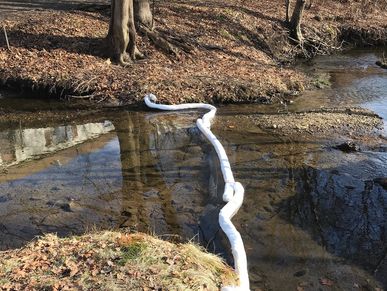Emergency Spill Response
Aboveground and Underground Storage Tank Removal
CMG Environmental responds to a broad range of emergency incidents promptly and efficiently. These incidents include: releases at transportation facilities, industrial facilities, utilities and energy facilities, as well as releases on roadways, railways, pipelines and waterways including lakes, rivers and tributaries.
Aboveground and Underground Storage Tank Removal
Aboveground and Underground Storage Tank Removal

When storage systems are no longer needed or are unsuitable for product storage, CMG Environmental will empty and place them in temporary out-of-service (UST) or removal-from-service (AST) condition, close them in-place or remove them. This avoids future safety and environmental hazards by ensuring that there is no available product to be released.
Low - Flow Groundwater Monitoring

CMG may field-screen groundwater during low-flow purging for pH, temperature and conductivity using a flow-through cell. When appropriate, we may also screen groundwater for oxidation-reduction potential (ORP) and dissolved oxygen (DO). Low-flow purging should continue until field parameters stabilize. To determine stabilization, take at least three sequential measurements:
· pH is stable when readings are within 0.1 Standard Units
· Temperature is stable when readings are within 0.3 °C
· Conductivity is stable when readings are within 3%
· ORP is stable when readings are within 10 mV
· DO is stable when readings are within 10% if >0.5 mg/L or when 3 sequential readings are <0.5 mg/L
Drinking Water Analysis

CMG samples drinking water wells located within 500 feet of any release or spill as required by DEP regulation (MA). We collect all drinking water samples in accordance with DEP protocols and conduct analysis at substantially lower method detection limits to ensure there are no health risks to those using the water supply wells.
Surface Water Oil Boom Protection
Surface Water Oil Boom Protection

CMG samples groundwater and surface water at release locations to evaluate the potential for migration from known releases or spills.
We evaluate groundwater quality to determine if a specific spill or release has migrated from overburden soil to the groundwater and if the underlying groundwater is creating an additional pathway for contamination to further migrate. CMG samples groundwater in accordance with state regulatory or best engineering protocols.
CMG samples surface water near a release or spill area to determine if the released chemicals could potentially create a health risk to aquatic life. We use state regulatory protocols during our sampling events.
Soil Sampling
Surface Water Oil Boom Protection

CMG collects soil samples from the surface and at five-foot intervals below the surface unless otherwise specified. We may collect additional soil samples at observed strata changes. We field-screen soil samples for total volatile organic vapors (TVOVs) with a portable photo-ionization detector (PID) in accordance with our “Soil Headspace Screening” protocol.
